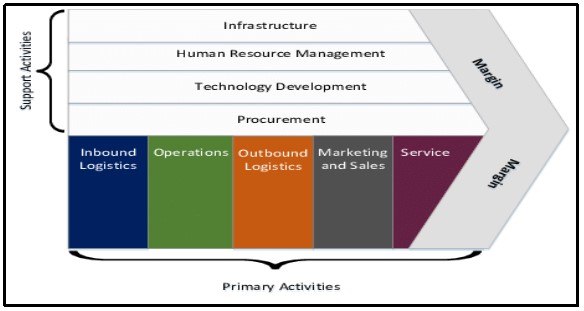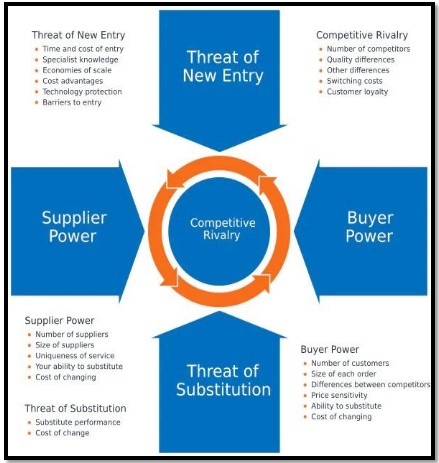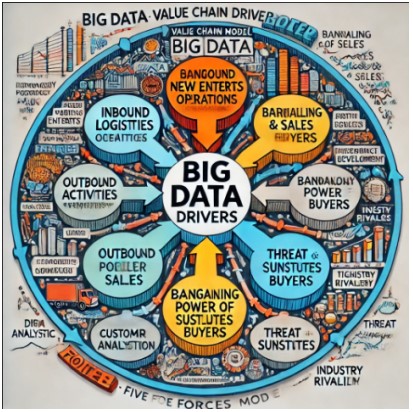Leveraging Big Data for Marketing Optimization and Industry Innovation MKT6032
- Subject Code :
MKT6032
Part A
1. Executive Summary
Big Data has emerged as one of the essential tools for the efficiency of up-to-date business processes because of its capability to assist with decisions on the behaviour of a consumer, the productivity of operations, and tendencies within a particular market. The increased possibility of structuring and unstructured data helps companies to make better decisions, improve the effectiveness of the workflows, and build effective customer experiences. Big Data in the context of todays cut-throat competition also allows for predictive analysis that would allow organizations to be prepared for changes in the market and minimize risky situations as well as bring more products to the market much quicker. Due to the outcomes based on analysis of Big Data, the companies can develop their supply chain management, to boost the satisfaction among customers and, as a result, revenues. However, the combination of Big Data with Artificial Intelligence or machine learning takes the measure to the next level to get smart automatically as well as for possibly higher accurate predictions.
Consequently, Big Data presents great potential to the marketing fraternity in that it creates the basis for a much more focused and individualized approach to marketing. Some insights revealed that Big Data helps to segment the audiences more accurately improving the conversion rate of marketing strategies. Consumers data analysis helps companies understand common patterns and, therefore, develop new content that will be of interest to certain groups. Predictive analysis of big data is also useful in predicting future consumer behaviour so that companies can be in a position to meet the customers needs before competitors do so.
2. Introduction
Big Data is akin to a revolution in the current world of business as organizations stand a chance to embark on new revolutions by using technology. Big data is defined by three Vs, volume, velocity, and variety where volume refers to the huge amount of data that can be processed, velocity refers to the fast rate of this data processing and variety refers to the different formats of data that businesses can get (Nnaji et al., 2024). Such an approach ensures enhanced efficiency of operations with particular reference to consumers, as well as flexibility in measure of innovation. Among all the branches of the industry, marketing is one of those that reveals the importance of Big Data most of all. Currently, marketers are facing a very large amount of information from various sources, including social networks, customers, and digital advertising.
3. Big Data in the Value Creation
Value Creation Using Big Data
Huge amount of data is now viewed as one of the cornerstones of creating value in the contemporary business environment and it can be used more effectively to optimize customer relationships and innovation and efficiency of business processes. With the ongoing customer interactions and market and organizational activities data, it is possible to identify new sources of value and competitive advantages.
Another benefit that Big Data generates is the one related to customer sensibility increase. Consumers conduct important information about themselves, so through researching consumers behaviour, preferences and buying habits; businessmen and women can be in a good position to understand their clients well to facilitate effective marketing and sale of their products. The type of personalization discussed up to this point enhances customer satisfaction and loyalty as well as increases conversion and sales (Wang et al., 2020). For instance, Big Data in retailers can be used to suggest goods that a customer has previously bought or looked at then the probability of making a sale increases together with the satisfaction of the customers.
Creativity in Big Data is also encouraged by identifying trends that are yet to rise as well as customer needs that are not yet met. Companies can adapt and innovate effectively when the market data is used in predictive analytics and the process, companies develop new products and new services which meet emerging market needs. This forward-looking perspective will keep organizations on their strategic toes and adapt swiftly to changing circumstances on the market (Benzidia et al., 2021).
Porters Value Chain Analysis
An outline of Porters Value Chain Model
The value Chain model is one of Porters strategic tools that helps to study activities within an organization in an attempt to define what sources of competitiveness it can use. The model classifies activity into two broad types: The primary category and the support category The primary activities are inbound logistics, processing, outbound logistics, sales/service, and marketing.
The ways that Big Data can strengthen each part of the work chain

Figure 1: Customized value chain diagram
(Source: https://www.researchgate.net/figure/Porters-value-chain-model)
- Inbound Logistics:Big Data can create added value in managing inventory and selecting suppliers (Mariani and Wamba, 2020).
- Operations: Production line analysis: Advanced analytics can also enhance the production line and quality management.
- Outbound Logistics: Big Data makes it easier to improve the distribution of routes and improves the control over supply chains. It aids in the organization of delivery and has information analysis that minimizes transportation expenses.
- Marketing & Sales: Big Data gives knowledge about the alteration of customer preferences and behaviour.
- Services: Another potential is making the customer service better due to the application of the data analytics that could predict customers needs. Porters Five Forces Analysis
An analysis of Porters Five Forces Model
The resource-based view is also known as the resource-grounded view, and it relates to the looking-glass theory by showing how an organizations resources might be seen as reflecting its competitive environment (Li and Zhang, 2021). It assesses five key forces that determine the intensity of competition and profitability in a market:

Figure 2: Porter's Five Forces diagram contextualized for the manufacturing industry
(Source: Li and Zhang, 2021)
Examination of each of the forces is affected by Big Data
Competitive Rivalry: Big Data improves competitive competition by giving firms a favourable view of the market and customers, competitive structure, and strategy.
Threat of New Entrants: Competing on Big Data can either decrease or increase the risk of entrant rivals (Patwa and Saleem, 2021). In the same breath, it may reduce the barriers to entry because entry-level firms can effectively learn about the market and patronage behaviour more so compared to entry into physical facilities.
Bargaining Power of Suppliers: Supplier power is a concept that can be cut across by Big Data by bringing about increased transparency in the operations of the supply chain.
Bargaining Power of Buyers: Big Data also entrenches the buyers power of bargaining since they gain access to clear information on products, prices, and available options.
The threat of Substitutes: Big Data assists organizations in tracking and analyzing the appearance of different products or service substitutes. Through evaluating the existence of the forces, the business organization gets a chance to innovate and adapt to some of the impacts of substitutes since consumers trends and preferences change constantly.
4. Leveraging Big Data for Industry Optimisation
New Business Insights and Big Data Opportunities
Big Data is a revolutionary concept that in the global marketing industry is vital in a way that provides sufficient new business insights that lead to decisions and innovations. Consumer analysis involves collecting and analysing large quantities of consumer data that marketers can use to develop a pattern of new trends as well as customer behaviours and preferences with a view of having the foresight of the market (Matarazzo et al., 2021).
Through the use of Big Data, it is also possible to fine-tune the marketing communication initiatives through detailed information on how the customers are engaging the company through different channels (Sestino et al., 2020). This ability will allow marketers to further calibrate their targeting messages so that promotional content hits the mark when it comes to audiences, and when it comes to driving engagement and conversion rates. In addition, Big Data can assist an organization in discovering new markets in addition to opportunities for growth.
Optimization
Marketing Big Data optimization refers to the process of employing the results of data analysis for the improvement of marketing activity. This way, marketers can increase the ROI of campaigns, improve the match between brand communications and consumers, ultimately, and gain useful insights not only for campaign design, but also for business development (Misra et al., 2020).
This process minimizes the frivolous expenses on mass, moreover general over messages and also improves the chances of delivering the right message to the right audience at the right time.
Marketing through Big Data can be done in real time and so businesses can tweak their approach accordingly. For instance, using customers feedback regarding various content forms or special promotion codes, it can immediately reveal successful and unsuccessful strategies and change them simultaneously (Sjdin et al., 2020). The dynamic approach to optimisation lifts conversion rates as well as improves customers satisfaction due to more relevant experiences.
Further, Big Data helps in the better control of the marketing mix as it identifies the right channel and media mix for the target markets. Organisations can make better decisions on which channel to allocate more of its resources to since some are performing better than others; and overall have a much better integrated and effective marketing communication campaign that will yield a much better ROI.
Revenue Opportunities
Personalized Offerings
Big Data makes it easier for marketers to make their insights detailed thus getting to understand the customer better creates closer marketing offers. Retailers and other organizations can gather large amounts of information on customers, and can then target content based on what the customer is likely to respond well to.
New Products or Services
Big Data is involved in answering questions on the market by focusing on trends and needs that are yet to be discovered. When performing the analysis of patterns, based on given demands, companies can forecast further demands and, thus, invent new products or services that will meet the needs of customers (Akhtar and Dani, 2020).
Market Expansion
Through Big Data, market growth areas are also recognized thus enabling expansion of the market. By the geographical and demographic breakdown, firms can find out the available markets and act accordingly. It is useful in assessing where to invest and how to manage the marketing mix to create successful market entry and additional revenues.
Industry Transformation
Big Data is revolutionizing the industries at its optimum level where in the way organizations work, create and compete. These impose enormous possibilities of reaching higher depths and surfaces of comprehensiveness in leapfrogging market intelligence, customers dynamism, and organization performance of the business to foster data-driven decisions to trigger growth and innovation (Aceto et al., 2020).
Using Big Data, there have been radical changes in how marketing is done in the business world. It makes it possible to segment the markets and engage in mass customization, a concept that entails targeting specific groups of customers with campaign that suits them. It also helps the clients to feel valued and gets higher conversion rate and royal customers.
However, Big Data also allows new trends to be seen and addressed more quickly than ever before by the businesses. The data consumption helps the organizations in identifying the change in customers requirements and coming up with the new products or enhanced services in the market in order to outcompete the close rivals (Maroufkhani et al., 2020).
5. Big Data Business Drivers and Their Impact
Big Data is powered by several key drivers that profoundly influence business operations and strategies:
Structured Data:
Structured data on the other hand is data that adhere to a well-defined format; and which can be easily searched and analyzed; and which may include such formats as databases or spreadsheets. This type of data is helpful to provide fast and specific results to the business since the information is straightforward and easy to act upon (Aceto et al., 2020).
Unstructured Data:
Unstructured data, on the other hand, is text-based and it is not linear or easily searchable, and it includes text, images, videos, and social media content and emails. This data type has a lot of potential, which is why it is a more valuable type of information it reveals the customers attitudes and behaviour.
Low Latency Data:
Low latency data means a capability to process and analyze data and make decisions based on them as soon as possible. Indeed, in such industries as finance or e-commerce low latency data is significant for responding to market shifts in real time.
Predictive Analysis:
It entails the identification of patterns in past and present data, and tries to estimate the occurrence of certain event in the future. This driver enables business to get in a position to predict the likely needs of its customers, manage stock, and make improvements to their marketing strategies (Ciampi et al., 2021).
6. Impact on Business Initiatives
Business improvements of the Big Data technology improve both the Value Chain model and Porters Five Force in an industry venture. Big Data in Value Chain creates sustainable efficiency and innovative value proposition in all the activities.

Integrated diagrams showing the impact of Big Data drivers on Both Models
(Source: Ciampi et al., 2021)
In operation, it increases production line efficiency and enhances quality management by use of analytics. Outbound logistics have optimized distribution routes to reduce the cost of transportation. Returned to customers, marketing and sales techniques are more enhanced with improved sales promotion and marketing activities.
Conclusion
The integration of Big Data into the marketing industry provides the following advantages; Through elaborate analysis of large data sets, marketing plans can be well-shaped and chained to individual consumers. Decision-making is real-time and makes adjustments to campaigns based on data to enhance the returns on investment.
Part B: Opportunities from Open Dataset
Dataset Identification and Selection
Dataset Overview
The dataset that has been identified for the study is Employment by Indigenous group and industry and it is found in the Open Government Portal of Canada and the dataset has been extracted based on Google Trends. This data set gives employment data regarding Indigenous groups in different sectors in Canada. Employment data is collected on an Indigenous identity basis, and the dataset provides information on the involvement of various Indigenous populations in distinct fields of activity.
Explanation for choice of the dataset
Google Trends has been chosen for this project because it provides actual-time information and contains vast information. This kind of dataset is very beneficial in identifying specific niches for advertisements and previous changes in customer conduct (Khan et al., 2021). The reason for choosing Employment by Indigenous group and industry lies in the fact that such information is helpful for business and policy considerations as well as for research about the employment state of Indigenous peoples and to target the key directions to Indigenous economic advancement.
Metadata Presentation
Data Type: CSV file
Key Variables:
Industry: Sectors in which Indigenous peoples are or can be engaged.
Indigenous Group: Several categories of Indigenous people have been parted and include, the First Nations people, the Mtis and the Inuit.
Employment Status: This means employment status in terms of indicators such as employed, unemployed and the rest.
Geographical Location: Official geographic subdivisions of Canada on the provincial or territorial level.
Keywords: First Nation and Aboriginal peoples employment analysis, industry development, and economic contribution, Canada.
Opportunities created by the dataset
Business Insight
The dataset remains of great value in understanding the economic interactions of Indigenous people. For example, employing organizations can determine certain sectors that employ more indigenous employees and how they can support those sectors through training or partnerships. (Chapman et al., 2020).
Optimisation and innovation
With the help of this dataset, sectors and regions can be compared and deficiencies in Indigenous employment could be seen to improve the companys diversity and inclusion policies. This can result in innovative ways of staffing, development and employee relations and contribution within the community, making the workforce diverse. (Panori et al., 2020).
Revenue Generation
The employment data of the Indigenous peoples can be used not only to diversify the companys human capital but also to open up new markets for the companys products and services in sectors in which the Indigenous peoples are active consumers and prospective customers. It can, therefore, lead to the expansion of the market share and enhance the revenue of the firm.
Are you struggling to keep up with the demands of your academic journey? Don't worry, we've got your back!
Exam Question Bank is your trusted partner in achieving academic excellence for all kind of technical and non-technical subjects. Our comprehensive range of academic services is designed to cater to students at every level. Whether you're a high school student, a college undergraduate, or pursuing advanced studies, we have the expertise and resources to support you.
To connect with expert and ask your query click here Exam Question Bank

